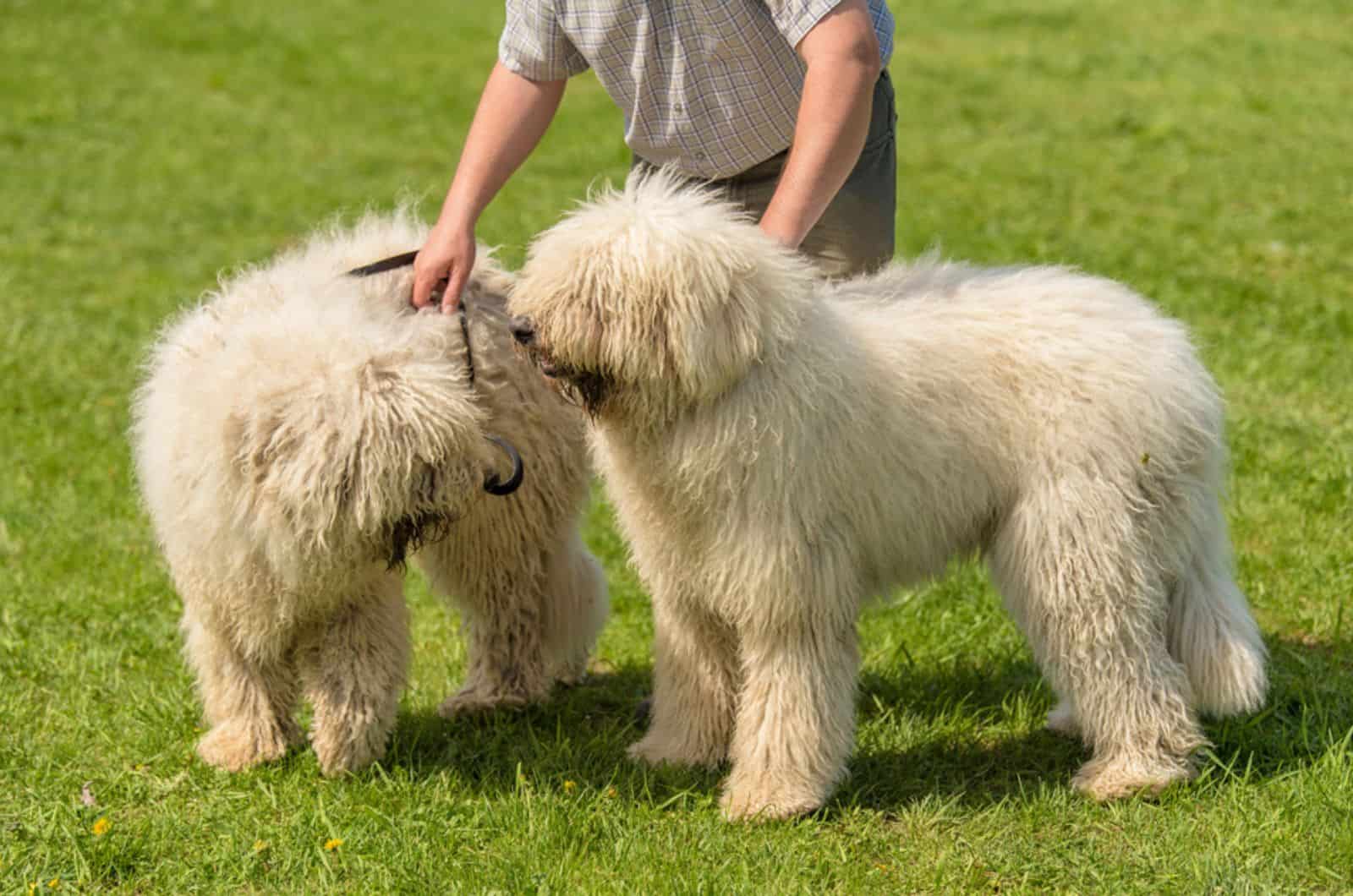A corded dog sounds like a lot of work, and it is. The Komondor’s coat is a specialty item in the world of grooming. Long or short coat, it all sums up to gently brushing and shampooing for maintenance.
Komondor grooming is different, to say the least. It is like trying to groom a sheep that slept in mud but worse. You will eventually sheer a sheep, but a Komondor without its corded coat is like a chicken with paws — odd to look at.
Hungary clearly had a grudge against the world when they pushed the mop dog into the spotlight, which is why we decided to create a simple Komondor grooming guide to share and ease the pain with you Komondor owners.
If you have a puppy, there is much more pre-cord work you have to do, and we will cover that subject, too. All that is left is to get right into it.
How To Do Komondor Grooming Properly
First things first. Most people get a Komondor puppy which, as you might have noticed, does not have a corded coat. It usually takes a couple of years for the dog to develop the dreads you see on show dogs or on the internet.
Getting to that point is going to require weekly baths and a lot of hair separation. Puppy Komondors have a fluffy coat that is intertwined with a softer undercoat. Brushes are a giant no for Komondor grooming.
These things take lots of time, and you will probably spend a good few hours every day grooming your Komondor. This dog breed is thankfully a low-shedder, just like a Poodle, but it is by no means “hypoallergenic”. We have a list of 25 Big dogs that are hypoallergenic if it tickles your fancy.
Let us get back to the topic at hand. I was talking about a guide on how to groom a Komondor, so here is the entire process of cleaning and preparing your puppy mop dog for a corded coat.
Puppy Komondor Bathing And Cord Prep
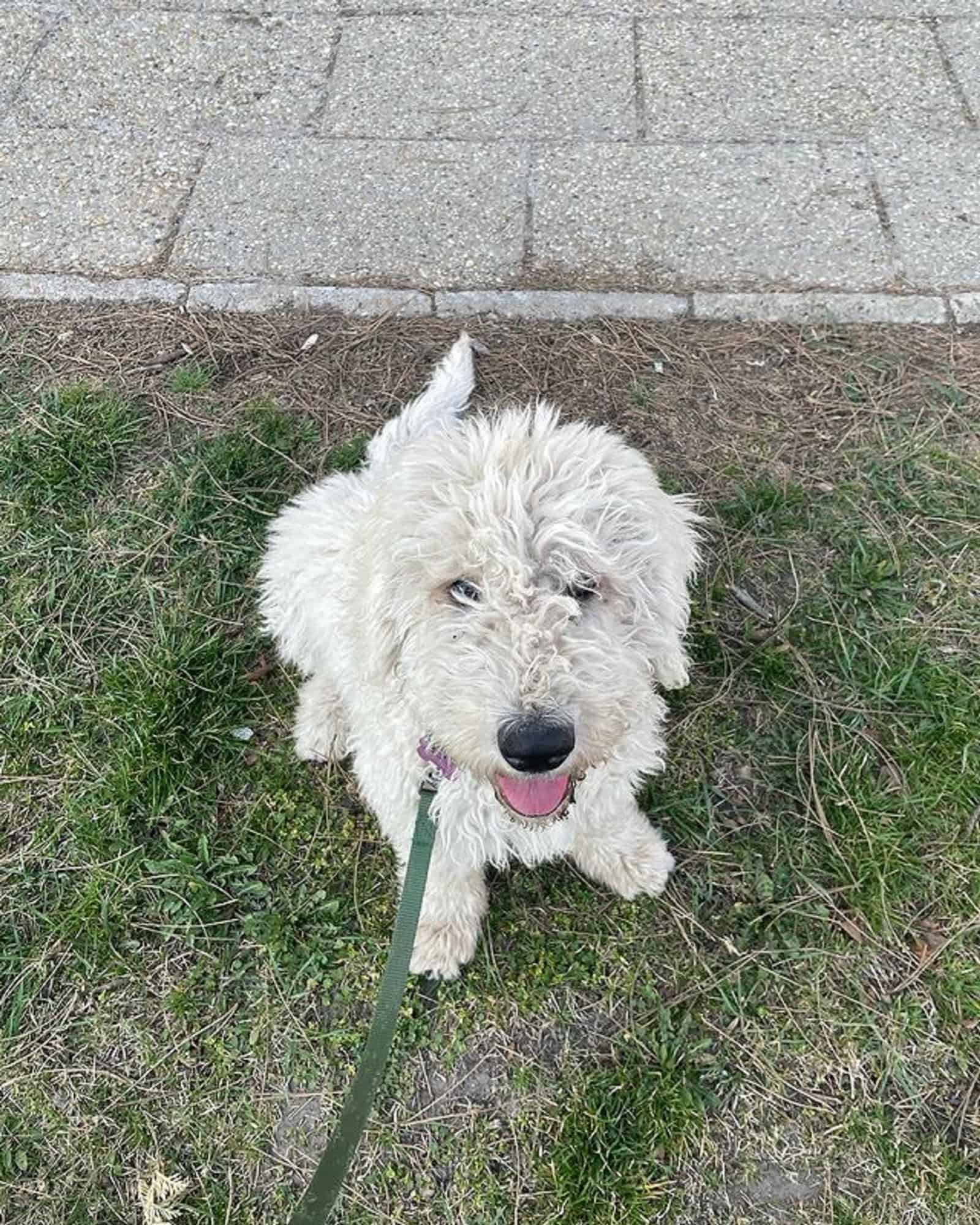
You will have to start separating strands of hair when the puppy is a few months old already. Sitting, lying, and playing in areas where there is a lot of water, dirt, soil, etc., will cause the coat to become heavier due to moisture.
Lying on its side or sitting will create plates of hair that look like a horse’s armor once dry. The undercoat retains a lot of moisture, so leaving all that dirt to dry for days will make it exponentially harder to detangle the hairs.
Depending on the amount of physical activity your dog engages in daily, you might have to bathe it a few times per week. Luckily, they have moderate exercise needs, so one bath a week should suffice.
Never put your Komondor directly in the bath and soak it wet. Use a spray bottle with clean water to moisten the hairs just enough so that you can create well-separated strands. You will have to manually do this, as a tool can be damaging to the dog’s future cords.
Start your way from the back towards the feet, and once the entire coat is pliable, carefully pull strands of hair away from the skin, creating a segment of any width you like. You should also shampoo the strands individually by softly pulling down on the while applying enough product.
Remember to squeeze the strands well so that no excess product or water remains within the coat. Once you are done (you should not take too long because a coat that is too wet will start clumping up again), take clean water and rinse each strand individually.
There Is More Than One Way To Dry A Komondor Coat
If the weather is nice and sunny, the best way to dry a Komondor’s coat is to leave it to dry on its own. That way, your dog will be able to walk freely and even play if you live in a house with a tidy yard.
The second way would be a hand towel. Although it is not the most efficient way, it can work well. Remember not to scrub or do any rubbing motions with the towel. Take the cord and put it in the towel, and squeeze the excess water out.
A blow dryer will be a good option if you want to get some of the stubborn pieces of dirt out of the coat along with drying the coat. Do not use the high-heat setting, as it can cause your dog to overheat.
Do not use a blow dryer on puppy coats because it may cause the cords to separate, ruining all your hard work from the previous hours. A young dog will become restless if you blow heat at it, so visible signs of discomfort are going to tell you when to stop.
Taking it to the next level in terms of convenience and effectiveness comes with the wet & dry vacuum. If you have one of these in your home, it will save you so much time. Properly made cords will not break or hurt the dog while using the vacuum.
Last but not least, the mighty cage dryer. Similar to the blow dryer but on a much larger scale, cage drying should be done at room temperature or cold air. Since it is an enclosure blowing air onto your dog’s body, overheating can be a frequent problem.
It is important to take breaks between cage drying sessions. Half an hour in, ten minutes out, and repeat. I would not recommend keeping the dog inside for longer than an hour. If your Komondor is very patient, then an hour might work.
Tips On Strand Width And Length
As a guideline, you can put your thumb and index finger together and use that as a width-measuring tool. Keep in mind that thin strands during puppyhood can fall out once the dog starts growing and developing cords.
The thumb plus finger formula works for the neck, chest, back, and thigh areas, while a thumb only is a good width on the face, ears, and lower legs. With age, your canine sheep’s coat will allow you to further separate the strands, opening the possibility for thinner cords in the future.
Length is important if you plan on showing your dog. According to AKC breed standards, trimming is not allowed, especially on the largest areas of the coat. The only trim you should do is a little bit around the genitals and potentially around the feet.
Neither is mandatory, but it is practical in terms of hygiene to shorten the hair around the genitals and around the anus because the bacteria and smell from urine and poop can stick around in the dense coat of the Komondor.
Ripping Hairs From Sensitive Areas
Making strands on a puppy’s coat will be a sensitive task, so be very gentle with the ears and head area in general. Your dog might become impatient and move around, so keep it steady and hold the hair near the skin to avoid pulling the strand and damaging the skin and follicles.
The tail in Komondor grooming is tougher than the rest of the body. The skin on it is thinner, and the hair follicles are closer to the surface. If you pull too fast and too hard, you might rip an entire chunk out and wait for the hair to grow back (which can take months, if not longer).
Sometimes, the hair does not even grow back, and the Komondor’s tail will have bald spots that do not look pretty and expose the tail skin to bacterial or fungal infections (pyoderma).
You Can Create Strands On A Dry Coat, Provided The Coat Is Clean
Maintaining the cleanliness of the coat is a lot less work than skipping grooming sessions and then doing the whole process from scratch. After you do the whole routine once, keeping the coat clean is probably the most important thing.
Bathing the Komondor once a week is still important, but if the strands you made start losing shape, you can always do it on a dry coat. The process of measuring the width is the same.
The hairs will “learn” to stick together the more times you do the process, so spotting the prototype dreads and detaching them from the skin should be a rather easy job. Remember to always be gentle with the ripping because a puppy’s skin is sensitive.
Adult Komondor Coat Maintenance And Grooming
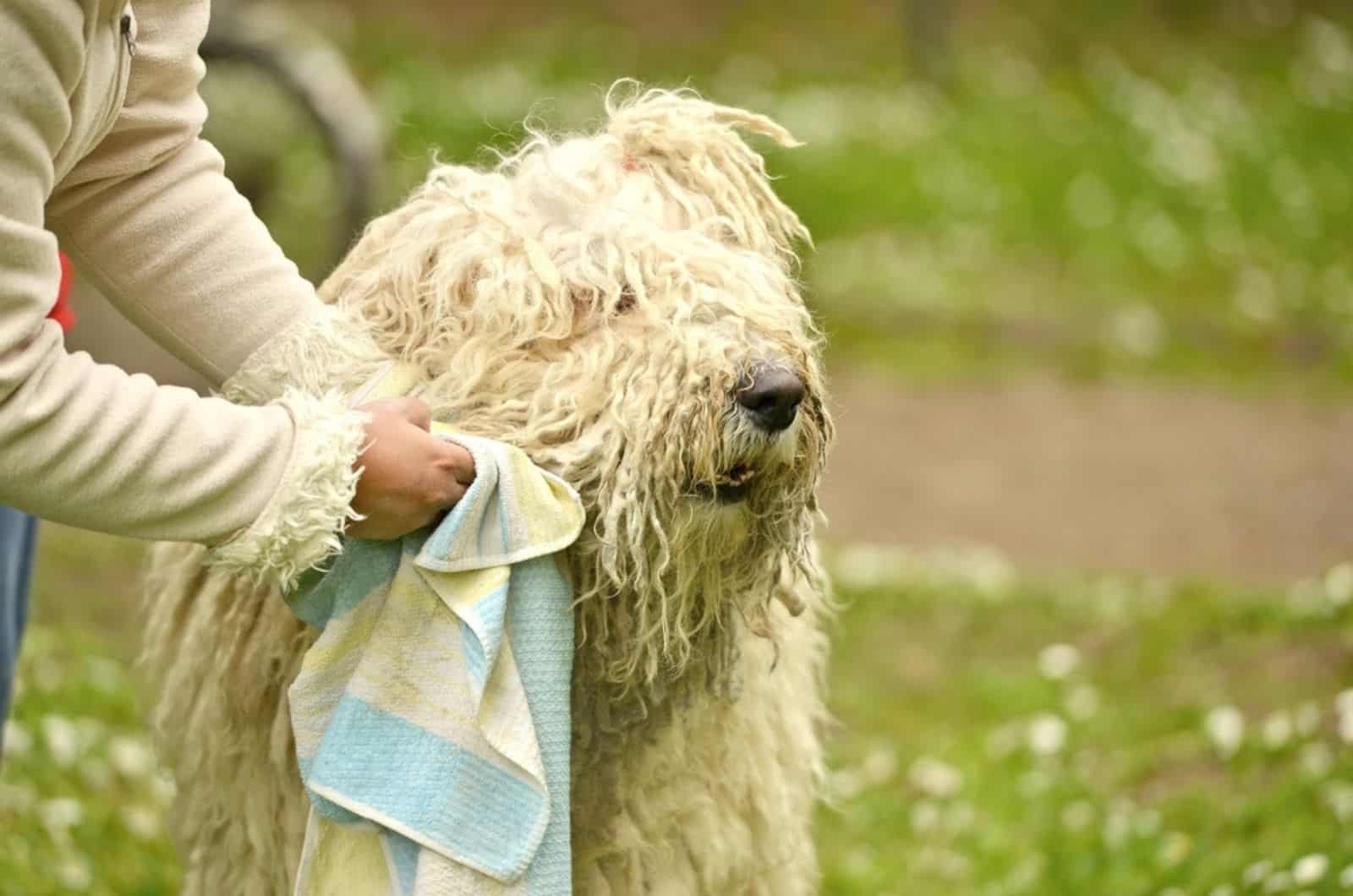
The Komondorok has one of the most drastic changes in dog hair growth in the canine world. From a fluffy crazy look into a cool, sheep-like outer coat.
After sixteen to eighteen months, your puppy will almost be an adult, so the cords will start taking the recognizable dreadlock look.
An adult dog’s coat will require less meticulous cord shaping, but there are a few differences between grooming a puppy and an adult coat. Since the breed was designed as a working dog, the outer, protective coat needs to be thick and weatherproof.
Spending time outside will most definitely get dirt, water, and other stuff on the Komondor’s cords, which means bathing. In terms of frequency, once a week is enough for an adult dog, and separating the strands will be much easier now that they are clearly defined.
Matting occurs when the dirty cords are stuck together, forming a plated look. This happens because the moisture retained in the hairs, combined with soil, debris, etc., flattens the coat while the dog is lying or sitting. Once it all dries up, you get panels of coat instead of cords.
Note that the weekly bathing is for show dogs. If you are not showing your dog at the moment or at all, you can feel free to bathe your Komondor as little as once or twice a month. Talk about easy Komondor grooming.
Do not be alarmed if you find solid objects between the cords. Komondors are dogs that love getting dirty, and removing leaves, grass, twigs, tiny stones, or gravel from in between the strands is something you will have to live with.
Revisiting The Width And Length
In terms of width, you can start making the cords thinner, as long as you pay attention that the root of the strand is thick enough to hold the weight of the entire cord. Never go less than a thumb-width across the entire coat.
Speaking about length, you should leave it as it is. A little trim around the paws and genitals should be more than enough. Never trim the hairs around the eyes because that is a disqualification in an American Kennel Club conformation event.
On a Komondor’s coat, you will find very few spots that have excess hair, as the dog breed is known to possess a self-maintaining coat. Do check with your respective organizations about cord length common rules.
You can always tie the cords around the eyes to provide the dog with a good field of vision. In the show ring, however, leaving those bangs hanging is the way to go.
Because the softer puppy undercoat mixes and intertwines with the outer coat of the adult dog, the natural shape of the cord will vary from one dog to another. Your Komondor might have easily-shapeable dreads or require more effort from your side to shape them well.
Although the plating we mentioned was related to bad things (clumping and flattening under the dog’s weight), some breeds, like the Bergamasco shepherd, have naturally plated cords. You can try pulling this off with your Komondor, but I believe that would be time-consuming.
On Using Whitening Shampoo
If your dog gets dirty a lot and you are humanly unable to clean it as often as you should, use a whitening shampoo to remove staining marks from the coat. You can mix the regular cleaning shampoo and the whitening one to avoid damaging the skin.
This product (whitening shampoo) should not be used all the time. It is mostly used prior to a dog show so that your Komondor can sport a pristine white coat. Consider using a skin care product to counteract the chemicals from the whitening shampoo.
For regular cleaning shampoo, you can use any of the twenty-two best-smelling shampoos we have come across. They are not only a delight to smell but are made to care for your dog’s skin as well.
Nails Require Grooming Too
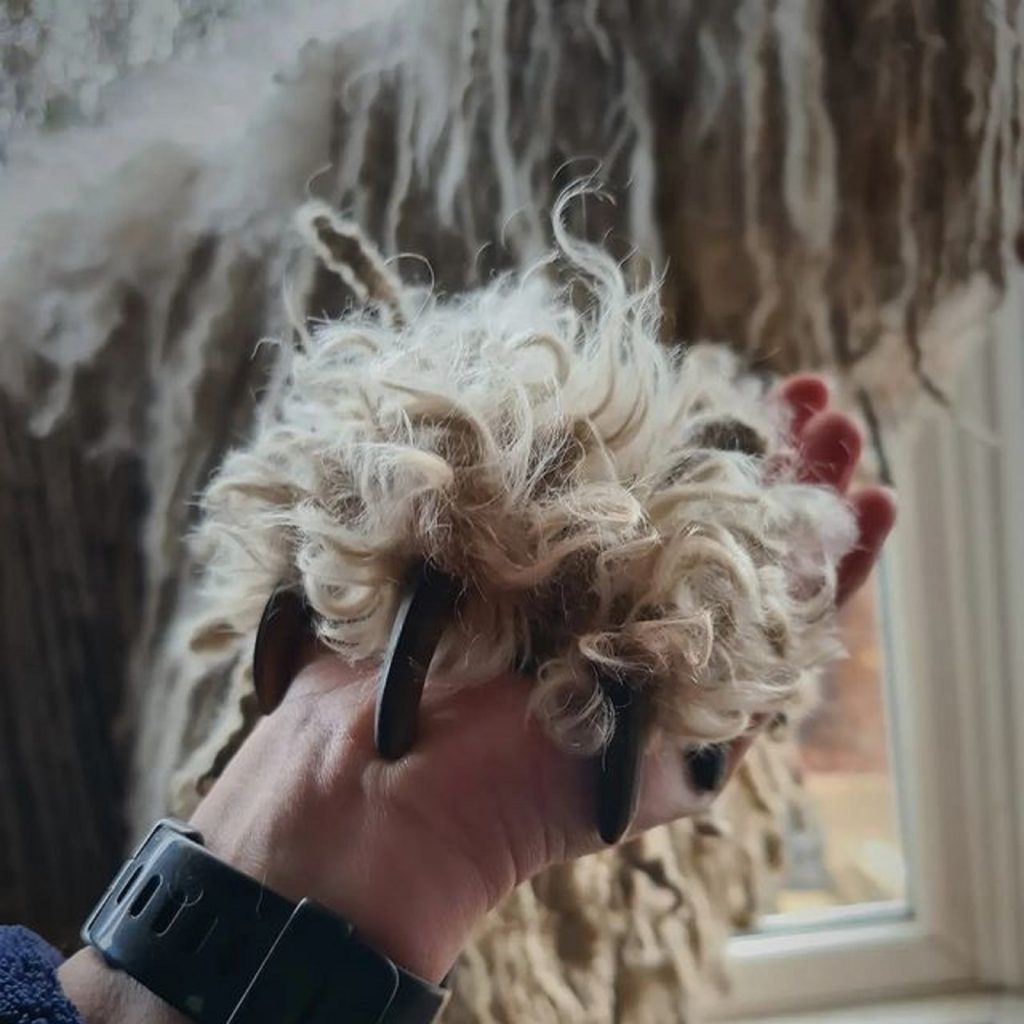
There is not much fuss about trimming a dog’s nail. Your Komondor does not mind having natural nails, but for the sake of avoiding potential injury or unwanted scratching around the house, it is nothing a pair of clippers cannot solve.
As with everything in life, how a nail trimming will go with your Komondor is up to the dog and your relationship with it. Some dogs require little to no easing into clipping the nails, while others shudder at the sight of a nail clipper.
You will have to hold the dog’s paw firmly without putting too much pressure on it. Do not remove any part of the nail further than the curvature. A dog’s quick is the part of the nail that contains capillaries and nerve endings, so you might hurt it if you cut too much.
Have someone assist you while clipping the nails, or consult our article on the best way to sedate your dog while nail clipping and alternative methods.
You can also try grinding your dog’s nails if cutting seems too difficult. Using a nail file for humans is out of the question because the structure of a dog’s nail is much denser and rougher than our nails.
Grind until before the curve in the nail and smooth out the rough endings so that your dog does not rupture its skin while scratching. There is always the option of asking a professional groomer or vet to show you how to do it or simply letting them do it.
One last tip — keep your Komondor’s cords away from the electric grinder. If the dreads get caught in the rotating head, it will be painful and can rip out the strand completely.
Make sure your Komondor is properly socialized before going to the grooming salon. Its strength and protective instincts might cause it to bite or topple the groomers. After all, they are strangers to your dog.
A Little Bit Of General Information About The Breed
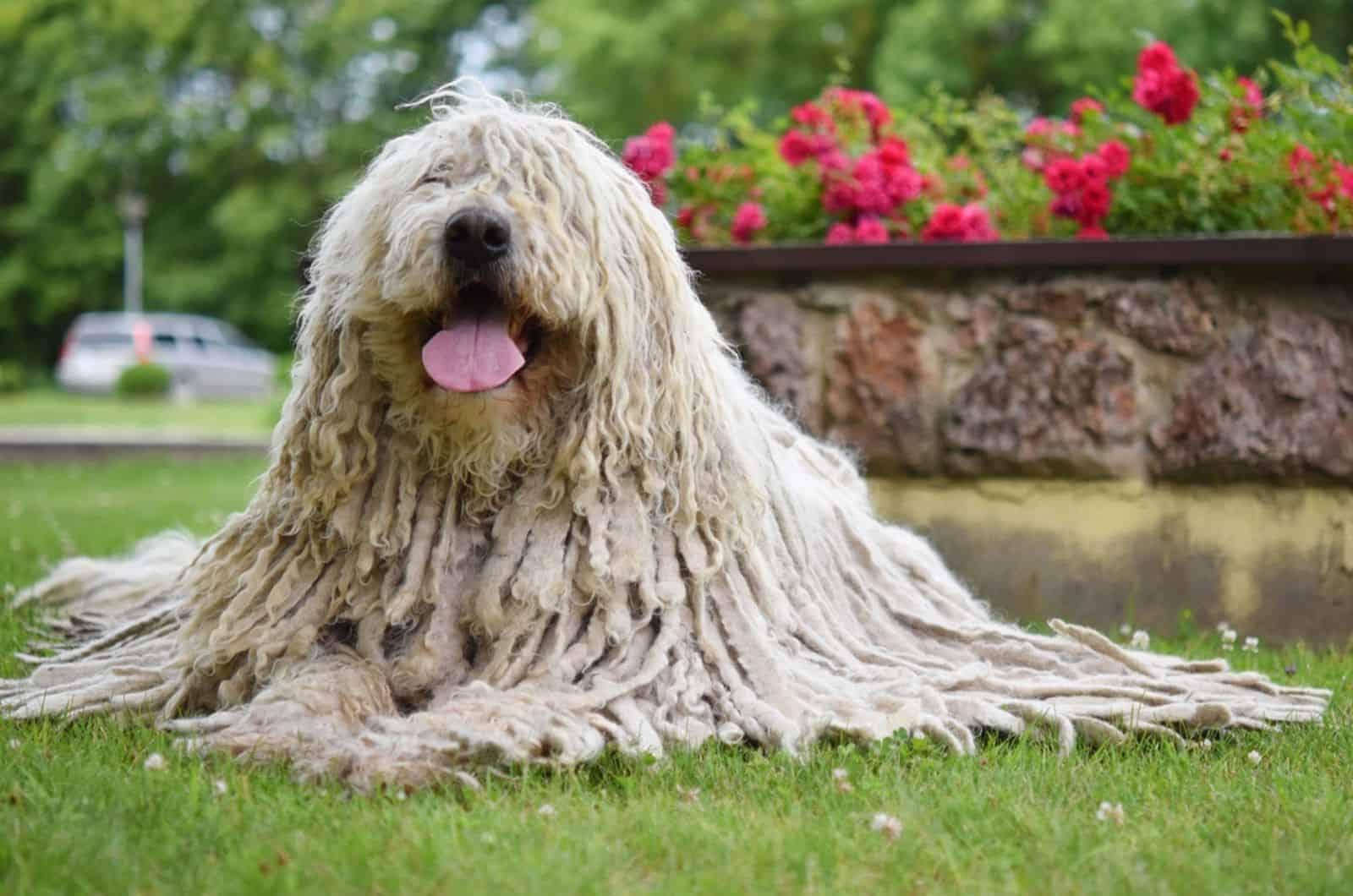
If you stumbled upon this article without knowing much about physical traits and temperament, let me summarize it for you. A rule of thumb is that a Komondor should be big and imposing at first sight.
The Komondor Club of America accepts a height of at least twenty-seven and a half with a weight of one hundred pounds minimum. Females are slightly shorter and should weigh no less than eighty pounds.
Although it has a distinct corded coat, the only color it comes in is white. It is one of the few large dog breeds that have only one color. Even the Bernese Mountain dog has three colors.
This is a strong dog breed with an acute sense of danger. Their large size matches their protective instincts, so the family will be always safe. As with all herding breeds, it will have a really strong work drive but is not a high-energy dog by any means.
In case you are looking for some more allergy-friendly but still protective, we recommend one of these twelve “hypoallergenic” guard dogs for a sneeze-free and safe house.
Living in a house with a large fenced yard will provide plenty of open space for exercise, but apartment life will warrant three or four short walks every day. Being intensely territorial, the further you go, the larger “its territory” will be.
Puppy Komondores have more energy, while an adult dog will be fine walking around the house while you prepare your meal. Most of the time, they will be alert and bark whenever they deem necessary.
Individualistic dogs from the sheepdog group are stubborn, so obedience training is mandatory if you want it to be well-behaved. Entertaining guests is most likely going to be a problem if you skip socialization during puppyhood.
This is a serious dog. The Komondor is not known for its playfulness, but it is moderately patient with young children. Socialization is key if you want to raise it alongside animals, as it is not fond of sharing its space with other dogs.
Health Problems, Lifespan, And Food
Komondor grooming and coat care do take a lot of time and patience, but it is worth having this dog breed in your home. They are a very healthy breed with minor problems, such as hip dysplasia, eye cataracts, and entropion.
However, the incidence of these genetic diseases is low if you purchase your pup from a reputable breeder. Make sure that the breeder performs DNA tests for common genetic health issues found in the Komondor.
Taking all the above into consideration, the Hungarian sheepdog has an average lifespan of ten to twelve years.
Dog owners should be aware of the fact that Komondors do not eat a lot. They are rugged dogs used to eating anything. If you live on a ranch or farm, and you own a working dog Komondorok, then it will expend all of its calories during working hours.
Those of you who live in houses without yards or apartments should be mindful of feeding too much fatty or bone content. A balanced large-breed diet with at least thirty percent protein content and a little bit of fat and carbs should work great.
A home-cooked diet is going to be a great choice for controlling calorie intake, especially with some boiled chicken and side dishes from our recipe book.
Do not feed your dog one large meal per day. Because of their deep-seated chest, they can be prone to bloat or gastric dilatation and volvulus (GDV). Split the daily calorie intake into two or three smaller meals per day.
Summary
There is no doubt about it — Komondor grooming is a gargantuan obligation. Owning this dog breed will take a lot of your time, so make sure you are ready for the commitment.
A fluffy puppy that you really liked will transform into a corded beast. Your expectations should be aligned with the adult dog’s physical appearance and temperament.
Make sure you go to a professional groomer who has already groomed Komondores if doing all of this yourself is not possible due to a lack of time, space, or anything in-between. This will require serious finances, so plan your spending ahead.
Lastly, do not forget that there is much more to a dog than its grooming needs and that despite all the money in the world, you will have to invest plenty of your own time to establish a trusting relationship with your canine sheep.
